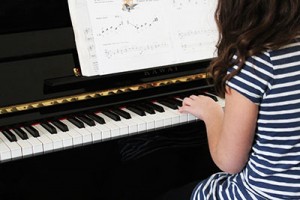An Easy Guide to Scientific Pitch Notation
Have you ever heard someone mention the notes C5 or A2 and had no idea what it means? It's actually from the American system for notating pitches, called Scientific Pitch Notation…
Have you ever heard someone mention the notes C5 or A2 and had no idea what it means? It's actually from the American system for notating pitches, called Scientific Pitch Notation…
Music Theory is the study of music. It's the study of how to make music, what music is, and what music could be. As the language of music has a…
The three foot pedals of the piano are not just there for appearance. Each of them has a purpose that aids in creating the desired sound on the piano. Unlike…
My online music store is now officially open! This is where I will sell audio recordings (like my upcoming Halloween songs and a Christmas Album!) and sheet music of my…
As a flute teacher, of course I'll say, yes! But that's not just because I'm biased. There are plenty of reasons why the flute is a good instrument to…
You may not know what "vocal fry" is, but guaranteed, you've heard it. Actually, you probably hear it all the time. And chances are, you may even use it all…
The best age to start learning music is whenever you want to learn. If you're wondering when to start music lessons, the time is now! The best age to start…
What musical instrument should your child learn to play? Good question! Helping your child choose an instrument when they have no idea what a clarinet or an oboe is can be tough. And what if they start an instrument but then they don’t like it? Or how do they make the right choice between two instruments if they’ve never played either (and neither have you)?
To help answer this question, I’m doing a series of blog posts. Part 1 is for everyone but especially for adults or teens trying to choose their own instrument. This post, Part 2, is primarily for parents trying to help their child choose an instrument. Part 3 will be for all audiences, and it will be my opinions on the experience of learning various specific instruments.
 Before I say anything else, I strongly recommend learning to play piano. SO many people have come up to me over the years, saying, “I wish I’d learned to play the piano!” or, “I wish I hadn’t quit taking piano lessons when I was a kid!” This by far the most common instrument to learn and in my opinion, it’s the most versatile. You can play music of any style on the piano and have a great time doing it! On piano your child can learn to play melody, harmony, and accompaniment all at the same time, which teaches them a great understanding of music as a whole. Learning piano also has all kinds of other benefits, and since it teaches you to read music for high notes AND low notes, it’s easier to go from learning piano to another instrument later. Piano has the greatest potential of any instrument to lead you in any musical direction you want to go. Schedule piano lessons with me here.
Before I say anything else, I strongly recommend learning to play piano. SO many people have come up to me over the years, saying, “I wish I’d learned to play the piano!” or, “I wish I hadn’t quit taking piano lessons when I was a kid!” This by far the most common instrument to learn and in my opinion, it’s the most versatile. You can play music of any style on the piano and have a great time doing it! On piano your child can learn to play melody, harmony, and accompaniment all at the same time, which teaches them a great understanding of music as a whole. Learning piano also has all kinds of other benefits, and since it teaches you to read music for high notes AND low notes, it’s easier to go from learning piano to another instrument later. Piano has the greatest potential of any instrument to lead you in any musical direction you want to go. Schedule piano lessons with me here.
One of the best ways to help a child choose which instrument to learn is by taking him to a school or a music store where each instrument can be demonstrated to him. Schedule a time with a music tutor or tutors to demonstrate what it is like to play the flute, the oboe, the clarinet, the trumpet, and so on. More than likely, your child will find a few favorites just by hearing them all played. Then, work it out so that your child can actually feel what it is like to hold each instrument. There will definitely be some awkwardness due to inexperience, but you and your child will both get an idea for what feels more natural for him. Also ask an instructor to tell your child the basics on how the instrument is operated – how is a sound made? Is it by blowing into something, by using a bow, by striking a key or by plucking a string? Different children will relate better to different instruments, and this is a great way to test that out initially before purchasing and pursuing their music education.
In Part 1, I shared some basic questions to ask before choosing an instrument. As a parent, you should ask your child these same questions and come to that decision together. Here are the same questions with answers from a parent’s perspective: (more…)